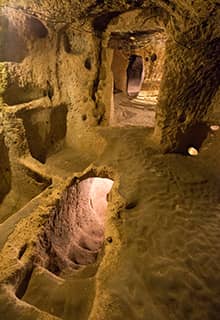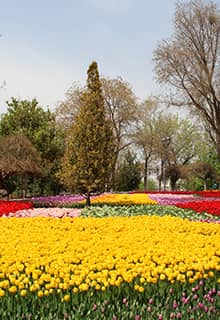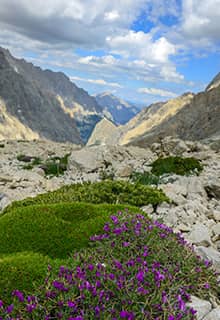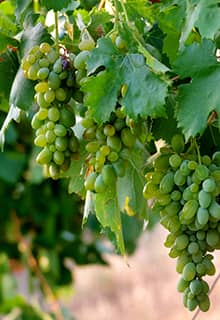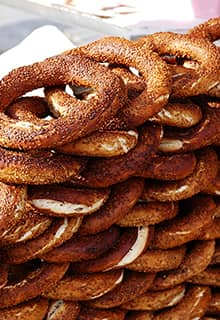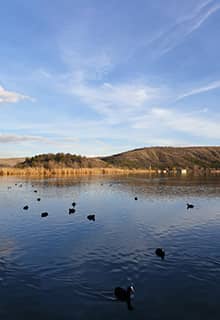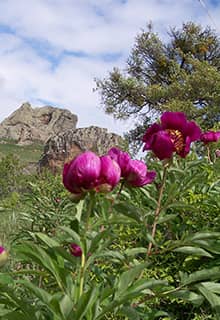

smell
Central Türkiye
Underground Cities of Kaymaklı and Derinkuyu in Cappadocia, Nevşehir
There are great number of underground settlements across Cappadocia while new ones are being discovered. People continued to work on the underground cities during also Roman and Byzantine periods, adding their own cultural and religious signatures such as churches. During their peak, these cities sheltered thousands of people.
Situated deep below Kaymaklı Castle, Kaymaklı Underground City features a maze of tunnels and rooms carved eight levels deep into the earth. The first floor was used as a stable, while the other levels include living quarters, a church and even graves. Nine kilometres from Kaymaklı, Derinkuyu (means “deep well” in Turkish) takes its name from the depth of the water wells here. It is a complex network of tunnels and rooms spread to seven levels consisting of stables, cellars, dining halls, churches, and storage areas.
Flowers of Eskişehir
Eskişehir has an enviable richness in terms of flora. Nearly 2000 plant species display natural distribution within the provincial borders. More than 220 of these species are endemic. 14 of these species, which grow in all mountains, steppes, plains, plateaus and forests, especially in the Sündiken and Turkmen Mountains, grow only in Eskişehir in the world.
The Great Oak in Çankırı
Located in the village of Karacaözü, 27 km from the Çankırı city centre, the oak tree is known to be over 400 years old and is considered among the oldest oaks in the world. The perimeter of the oak, which amazes those who see it, is 14.10 meters.
Tuzla Lake in Kayseri
As a part of the Kızılırmak River, the Tuzla Lake (Tuzla Gölü) is surrounded by reeds, wet meadows, salty vegetation steppes, pastures, and agricultural lands. Due to the decrease in rainfall and the increased evaporation during the summer months, the lake area shrinks and the salt in the water is deposited on the edge of the lake. In areas where lake water is drawn, a salt layer of 10-15 cm forms. The lake’s surrounding area was the residential area of many civilizations since the beginning of the 2nd millennium BCE, from the Hittites to the Ottoman Empire, and was one of the major intersections of migration and trade routes. Located on the historical Silk Road, there are many inns, caravansaries, mosques, and social complexes such as the Sultanhanı, which have survived until today.
Roses in Kırşehir
Considered the queen of flowers thanks to its fragrance and beauty, the rose's homeland is Anatolia and Central Asia. In Kırşehir, which is also known as Gülşehri (Land of Roses) in the past, roses found in almost every garden have been the subject of folk songs. The local people use rose leaves in making jam.
Lavender Valley in Kırıkkale
Kırıkkale has a lavender valley in Balışeyh district for two years! By visiting Lavender Valley, you can smell one of the most beautiful savour you can ever find, and you can also take amazing photos.
Tropical Butterfly Garden in Konya
Konya Tropical Butterfly Garden, located in the city center, has a total usage area of 7,600 square meters with a trip area of 3,500 square meters.
1,600 square meters of butterfly flight area offers natural habitat for 15 species of butterflies. There are 20,000 plants belonging to 98 species in the garden, and butterflies can be observed flying around their nectar plants.
When you enter the garden, you will encounter a unique atmosphere with thousands of plants and butterflies.
You will discover butterflies, the enormous colorful jewels of nature, in their natural life. You will witness the harmony of butterflies and nature in a tropical environment and have the opportunity to see the perfect patterns of their elegant wings.
Gölbaşı Love Flower (Centaurea Tchihatcheffii) in Ankara
Gölbaşı Love Flower (Centaurea Tchihatcheffii) which is among the endemic plants of Ankara. It was found by Hippocrates and took its name from mythological creature, the Centaur. Colloquially called as Red Centaurea, Iridescent, and Bride Button, this plant has red, purple, and pink flowers. According to the legend, it blossoms every spring as a grieve to the situation of two young lovers whose relation is impossible and tells the story of this desperate love with its different colors. They usually raise at the East part of Mogan Lake. This species is endangered due to excessive collecting, fatal effect of pesticides, afforestation, and construction activities.
A Large Variety of Fruit and Vegetables in Cappadocia, Nevşehir
In Cappadocia region, all manner of fruit trees such as quince, apple, pear, apricot, plum and even walnut and mulberry trees are cultivated and grown in orchards. In addition, the poplar which grows by the streams and rivers supplies the region with its timber and wood. Cappadocia is also an excellent grape-growing district, because the porous tuff soil is quick to save the little rain the area receives. Larger fields are often used for growing wheat, which the locals mostly pasteurize and turn into "bulgur".
The small vegetable allotments and gardens are mainly used to grow pumpkins, melons, beans, chickpeas, onions, potatoes, and tomatoes, alongside greens, mint and other garden herbs.
Kızılırmak River in Sivas, Kayseri, Nevşehir, Kırşehir, Kırıkkale, Ankara, Çankırı
The Kızılırmak, meaning Red River in Turkish, is 1,355 km long and is the longest river of Türkiye which rises and ends within the country. The river is born from Kızıldağ Mountains in the northeast of Central Anatolia, passes from Sivas, Kayseri, Nevşehir, Kırşehir, Kırıkkale, Ankara, Çankırı, Çorum and Samsun cities, reaching the Black Sea at Bafra. Some of the dams built on Kızılırmak are: Kesikköprü, Hirfanli, Kapulukaya, Altınkaya and Derbent.
The town of Avanos in Cappadocia set on the banks of the Kızılırmak is one of the best places to experience the river. Avanos is famous for its markets, and this is one of the top places to visit in Cappadocia. Based at about eight km from Göreme, Avanos has a lively centre with all the usual amenities including a modern, and a tourist-oriented hamam (Turkish Bath). It is also famous for its pottery and ceramics and there are workshops and galleries in the town. The clay for the local pottery industry is from the river. And, of course, there is fish from the Kızılırmak River and many local mezes.

